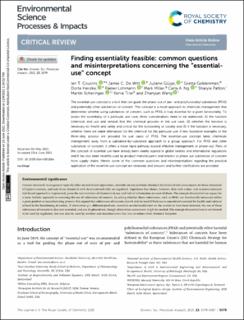| dc.contributor.author | Cousins, Ian T. | |
| dc.contributor.author | Dewitt, Jamie C. | |
| dc.contributor.author | Glüge, Juliane | |
| dc.contributor.author | Goldenman, Gretta | |
| dc.contributor.author | Herzke, Dorte | |
| dc.contributor.author | Lohmann, Rainer | |
| dc.contributor.author | Miller, Mark | |
| dc.contributor.author | Ng, Carla A. | |
| dc.contributor.author | Patton, Sharyle | |
| dc.contributor.author | Scheringer, Martin | |
| dc.contributor.author | Trier, Xenia | |
| dc.contributor.author | Wang, Zhanyun | |
| dc.date.accessioned | 2021-11-10T11:25:56Z | |
| dc.date.available | 2021-11-10T11:25:56Z | |
| dc.date.created | 2021-07-16T10:12:04Z | |
| dc.date.issued | 2021 | |
| dc.identifier.citation | Environmental Science: Processes & Impacts. 2021, 23, 1079-1087. | en_US |
| dc.identifier.issn | 2050-7887 | |
| dc.identifier.uri | https://hdl.handle.net/11250/2828863 | |
| dc.description.abstract | The essential-use concept is a tool that can guide the phase-out of per- and polyfluoroalkyl substances (PFAS) and potentially other substances of concern. This concept is a novel approach to chemicals management that determines whether using substances of concern, such as PFAS, is truly essential for a given functionality. To assess the essentiality of a particular use case, three considerations need to be addressed: (1) the function (chemical, end use and service) that the chemical provides in the use case, (2) whether the function is necessary for health and safety and critical for the functioning of society and (3) if the function is necessary, whether there are viable alternatives for the chemical for this particular use. A few illustrative examples of the three-step process are provided for use cases of PFAS. The essential-use concept takes chemicals management away from a substance-by-substance approach to a group approach. For PFAS and other substances of concern, it offers a more rapid pathway toward effective management or phase-out. Parts of the concept of essential use have already been widely applied in global treaties and international regulations and it has also been recently used by product manufacturers and retailers to phase out substances of concern from supply chains. Herein some of the common questions and misinterpretations regarding the practical application of the essential-use concept are reviewed, and answers and further clarifications are provided. | en_US |
| dc.language.iso | eng | en_US |
| dc.rights | Navngivelse-Ikkekommersiell 4.0 Internasjonal | * |
| dc.rights.uri | http://creativecommons.org/licenses/by-nc/4.0/deed.no | * |
| dc.title | Finding essentiality feasible: common questions and misinterpretations concerning the “essential-use” concept | en_US |
| dc.type | Peer reviewed | en_US |
| dc.type | Journal article | en_US |
| dc.description.version | publishedVersion | en_US |
| dc.source.pagenumber | 1079-1087 | en_US |
| dc.source.volume | 23 | en_US |
| dc.source.journal | Environmental Science: Processes & Impacts | en_US |
| dc.identifier.doi | 10.1039/D1EM00180A | |
| dc.identifier.cristin | 1921919 | |
| cristin.ispublished | true | |
| cristin.fulltext | original | |
| cristin.qualitycode | 1 | |

